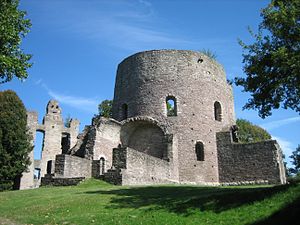Krukenburg
| Krukenburg | ||
|---|---|---|
|
The Krukenburg |
||
| Creation time : | 1215 to 1220 | |
| Castle type : | Hilltop castle | |
| Conservation status: | ruin | |
| Standing position : | Clergy, nobles | |
| Place: | Bad Karlshafen - Helmarshausen | |
| Geographical location | 51 ° 37 '57 " N , 9 ° 27' 32" E | |
| Height: | 184.2 m above sea level NHN | |
|
|
||
The Krukenburg belongs with the Sababurg and the Trendelburg to the trio of North Hessian castles in the catchment area of the Reinhardswald . It is located in the Helmarshausen district of Bad Karlshafen in the Kassel district .
geography
The hilltop castle ruin is located about 290 m north of the village of Helmarshausen, a district of Bad Karlshafen not far from the northern end of the Reinhardswald and about 500 m southwest of the Karlshafen colony of Nollendorf . It is located at 184.2 m above sea level. NHN high Waltersberg , the summit of which is about 80 m above a bend in the river Diemel ; The latter flows into the Weser 1.4 km northwest of the ruins in the Karlshafen city center .
The Krukenburg can be reached from Bad Karlshafen via the side street Graseweg which branches off from the federal highway 83 in Nollendorf approximately to the south-south-west and when coming from Helmarshausen via the side street Am Krukenberg which branches off from the B 83 to the east-northeast .
history
Of the three castles mentioned above, it is the castle with the oldest history. It is also a special case in terms of architectural history. In the middle of the castle complex is a church building built from 1107, the floor plan of which is in the form of a cross around a round building ( rotunda ) with a diameter of over 13 m. This central building was completed in 1126 and consecrated by Paderborn Archbishop Heinrich II von Werl Johannes the Baptist , which suggests that numerous baptisms took place here and that an early Christian cult site existed here, possibly long before the Helmarshausen monastery was founded ( 997). The construction followed the model of the Church of the Holy Sepulcher in Jerusalem. One of the first abbots of the monastery, Wino, is said to have brought the plans with him from a pilgrimage to Jerusalem around 1030 (cf. the Busdorf Church , Paderborn).
The history of the Krukenburg is closely linked to the history of the place and the Helmarshausen monastery. Because of disputes between the dioceses of Cologne , Paderborn and Trier , the construction of a classic castle around the round church and to protect the monastery began between 1215 and 1220 . The strong walls with towers, a moat, the castle gate and the keep belonged to it and are still recognizable today. The construction of the fortifications is attributed to Cologne Archbishop Engelbert I of Cologne . The bishopric of Cologne pledged the castle to Count Hermann von Everstein in 1223 . In 1338 the castle was pledged to the Archdiocese of Paderborn . This built the "Paderborn House" in 1338. The “Mainzer Haus” (abbot's apartment) and a residential tower that were built between 1401 and 1405 were among the younger buildings . Disputes between the Hessian Landgrave Ludwig II of Hesse and Paderborn led to the Landgrave's conquest of the castle in 1465. The castle came under Hessian protection in 1479. In 1496 Paderborn succeeded in buying back part of the castle and appointed a bailiff . Landgrave Moritz von Hessen-Kassel bought back the Paderborn share in 1597. After 1617 the castle gradually fell into disrepair, and large parts were later demolished for material extraction.
The Krukenburg ruin was restored in the 1970s.
tourism

The Krukenburg ruin is a popular destination. The keep can be climbed and from its viewing platform offers a panoramic view of parts of the north Hessian mountainous region and the Solling , the old historical town of Helmarshausen and the monastery area as well as parts of Bad Karlshafen.
The Café zur Krukenburg is located in Helmarshausen about 220 m west-southwest of the castle ruins .
Around 360 m north-northeast in Nollendorf there is an ensemble of buildings from the early 18th century, the former sheep farm with a tradition of over 300 years in agriculture and sheep breeding . This late baroque courtyard consists of a house with a former farm garden and a barn from 1703. The latter building was redesigned from 2001 (awarded the Hessian Monument Preservation Prize in 2005) and from 2003 used as a Café Schäferscheune ; The café is currently closed (as of March 2017) .
literature
- Rudolf Knappe: Medieval castles in Hessen. 800 castles, castle ruins and fortifications. 3. Edition. Wartberg-Verlag, Gudensberg-Gleichen 2000, ISBN 3-86134-228-6 , p. 16 f.
- Rolf Müller (Ed.): Palaces, castles, old walls. Published by the Hessendienst der Staatskanzlei, Wiesbaden 1990, ISBN 3-89214-017-0 , pp. 26-28.
Web links
- Krukenburg, Kassel district. Historical local dictionary for Hessen. (As of July 24, 2010). In: Landesgeschichtliches Informationssystem Hessen (LAGIS).
- View of Helmarshausen and the Krukenburg ruins, 1850. Historical views of the town, plans and floor plans. (As of January 5, 2009). In: Landesgeschichtliches Informationssystem Hessen (LAGIS).
- Krukenburg Museum / Gallery Information about the castle and the Helmarshausen monastery (Weser Gallery)
- Krukenburg ruins , on bad-karlshafen.de



